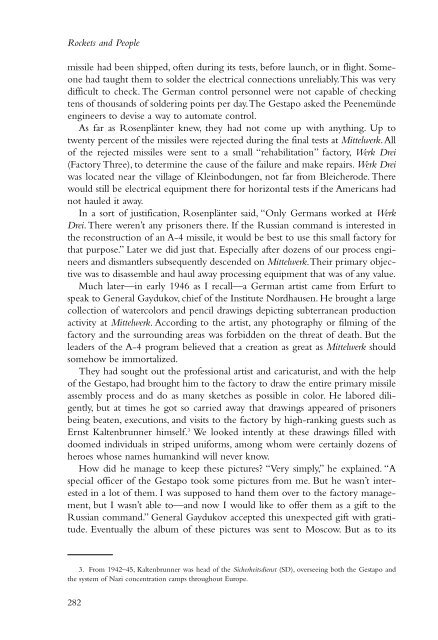to open next chapter. - NASA's History Office
to open next chapter. - NASA's History Office
to open next chapter. - NASA's History Office
Create successful ePaper yourself
Turn your PDF publications into a flip-book with our unique Google optimized e-Paper software.
Rockets and People<br />
missile had been shipped, often during its tests, before launch, or in flight. Someone<br />
had taught them <strong>to</strong> solder the electrical connections unreliably.This was very<br />
difficult <strong>to</strong> check. The German control personnel were not capable of checking<br />
tens of thousands of soldering points per day.The Gestapo asked the Peenemünde<br />
engineers <strong>to</strong> devise a way <strong>to</strong> au<strong>to</strong>mate control.<br />
As far as Rosenplänter knew, they had not come up with anything. Up <strong>to</strong><br />
twenty percent of the missiles were rejected during the final tests at Mittelwerk.All<br />
of the rejected missiles were sent <strong>to</strong> a small “rehabilitation” fac<strong>to</strong>ry, Werk Drei<br />
(Fac<strong>to</strong>ry Three), <strong>to</strong> determine the cause of the failure and make repairs. Werk Drei<br />
was located near the village of Kleinbodungen, not far from Bleicherode. There<br />
would still be electrical equipment there for horizontal tests if the Americans had<br />
not hauled it away.<br />
In a sort of justification, Rosenplänter said, “Only Germans worked at Werk<br />
Drei.There weren’t any prisoners there. If the Russian command is interested in<br />
the reconstruction of an A-4 missile, it would be best <strong>to</strong> use this small fac<strong>to</strong>ry for<br />
that purpose.” Later we did just that. Especially after dozens of our process engineers<br />
and dismantlers subsequently descended on Mittelwerk.Their primary objective<br />
was <strong>to</strong> disassemble and haul away processing equipment that was of any value.<br />
Much later—in early 1946 as I recall—a German artist came from Erfurt <strong>to</strong><br />
speak <strong>to</strong> General Gaydukov, chief of the Institute Nordhausen. He brought a large<br />
collection of watercolors and pencil drawings depicting subterranean production<br />
activity at Mittelwerk. According <strong>to</strong> the artist, any pho<strong>to</strong>graphy or filming of the<br />
fac<strong>to</strong>ry and the surrounding areas was forbidden on the threat of death. But the<br />
leaders of the A-4 program believed that a creation as great as Mittelwerk should<br />
somehow be immortalized.<br />
They had sought out the professional artist and caricaturist, and with the help<br />
of the Gestapo, had brought him <strong>to</strong> the fac<strong>to</strong>ry <strong>to</strong> draw the entire primary missile<br />
assembly process and do as many sketches as possible in color. He labored diligently,<br />
but at times he got so carried away that drawings appeared of prisoners<br />
being beaten, executions, and visits <strong>to</strong> the fac<strong>to</strong>ry by high-ranking guests such as<br />
Ernst Kaltenbrunner himself. 3 We looked intently at these drawings filled with<br />
doomed individuals in striped uniforms, among whom were certainly dozens of<br />
heroes whose names humankind will never know.<br />
How did he manage <strong>to</strong> keep these pictures? “Very simply,” he explained. “A<br />
special officer of the Gestapo <strong>to</strong>ok some pictures from me. But he wasn’t interested<br />
in a lot of them. I was supposed <strong>to</strong> hand them over <strong>to</strong> the fac<strong>to</strong>ry management,<br />
but I wasn’t able <strong>to</strong>—and now I would like <strong>to</strong> offer them as a gift <strong>to</strong> the<br />
Russian command.” General Gaydukov accepted this unexpected gift with gratitude.<br />
Eventually the album of these pictures was sent <strong>to</strong> Moscow. But as <strong>to</strong> its<br />
3. From 1942–45, Kaltenbrunner was head of the Sicherheitsdienst (SD), overseeing both the Gestapo and<br />
the system of Nazi concentration camps throughout Europe.<br />
282
















